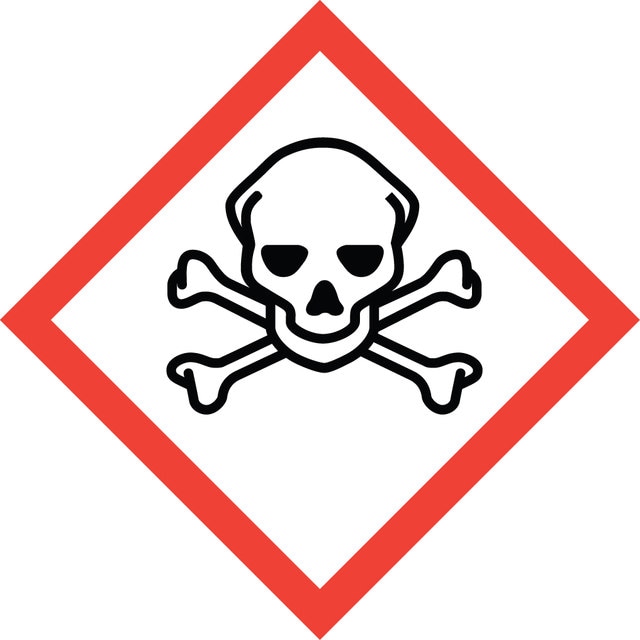方案
≥98.0%
mp
123-125 °C
溶解性
toluene: soluble 0.5 g/10 mL, clear to faintly turbid, yellow to brown
官能团
ketone
SMILES字符串
CC1=CC(=O)C(C)=CC1=O
InChI
1S/C8H8O2/c1-5-3-8(10)6(2)4-7(5)9/h3-4H,1-2H3
InChI key
MYKLQMNSFPAPLZ-UHFFFAOYSA-N
一般描述
2,5-二甲基-1,4-苯醌是醌衍生物。在 pH 7.8 的磷酸盐缓冲液中研究了其与刀豆脲酶的反应。它是棘头虫防御性分泌的成分之一。在 pH 7.0 的 50 mM 磷酸盐缓冲液中,对其作为刀豆脲酶抑制剂进行了研究。
应用
2,5-二甲基-1,4-苯醌可能用于参与 (-) -胱抑素 A 3 全合成的关键步骤。
警示用语:
Danger
危险分类
Acute Tox. 3 Oral - Eye Irrit. 2 - Skin Irrit. 2 - STOT SE 3
靶器官
Respiratory system
储存分类代码
6.1C - Combustible acute toxic Cat.3 / toxic compounds or compounds which causing chronic effects
WGK
WGK 3
闪点(°F)
Not applicable
闪点(°C)
Not applicable
个人防护装备
dust mask type N95 (US), Eyeshields, Faceshields, Gloves
J Cao et al.
Biochimica et biophysica acta, 1015(2), 180-188 (1990-02-02)
Upon illumination, a dark-adapted photosynthetic sample shows time-dependent changes in chlorophyll (Chl) a fluorescence yield, known as the Kautsky phenomenon or the OIDPS transient. Based on the differential effects of electron acceptors such as 2,5-dimethyl-p-benzoquinone (DMQ) and 2,6-dichloro-p-benzoquinone (DCBQ) on
S Kumazawa et al.
Journal of bacteriology, 154(1), 185-191 (1983-04-01)
Whole cells of photoanaerobically grown Chromatium sp. strain Miami PBS1071, a marine sulfur purple bacterium, oxidized H2 in the dark through the oxyhydrogen reaction at rates of up to 59 nmol of H2 per mg (dry weight) per min. H2
M Floreani et al.
The Journal of pharmacology and experimental therapeutics, 260(2), 468-473 (1992-02-01)
In guinea pig and rat cardiac tissue, redox cycling benzoquinones (2,5-dimethyl-p-benzoquinone and duroquinone) and naphthoquinones (menadione and 2,3-dimethoxy-1,4-naphthoquinone) generated superoxide anion (O2-.) both through one- and two-electron reductions, the generation being significantly greater in guinea pig than in rat tissue.
Dale E Ward et al.
Organic letters, 9(15), 2843-2846 (2007-06-22)
The total synthesis of (-)-cyathin A3 is described. The key step involves an unusual enantioselective Diels-Alder reaction of 2,5-dimethyl-1,4-benzoquinone with 2,4-bis(trimethylsilyloxy)-1,3-pentadiene, using Mikami's catalyst [(R)-BINOL + Cl2Ti(OiPr)2 + 4 A mol sieves] modified by addition of Mg and SiO2. Because
Thomas Eisner et al.
The Journal of experimental biology, 207(Pt 8), 1313-1321 (2004-03-11)
The opilionid Acanthopachylus aculeatus was shown to produce a defensive secretion containing quinones (2,3-dimethyl-1,4-benzoquinone, 2,5-dimethyl-1,4-benzoquinone and 2,3,5-trimethyl-1,4-benzoquinone), confirming the findings reported nearly a half century ago in a classic study. The mechanism by which the opilionid puts the secretion to
我们的科学家团队拥有各种研究领域经验,包括生命科学、材料科学、化学合成、色谱、分析及许多其他领域.
联系客户支持